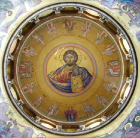Epistle to Titus
| Part of the series on Eastern Christianity | |

| |
|
History | |
|
Traditions | |
|
Liturgy and Worship | |
|
Theology | |
In the Christian New Testament, Titus, (a common Roman name, meaning honourable) was a companion of Paul of Tarsus, mentioned in several of Paul's epistles, including the Epistle to Titus. Titus was with Paul and Barnabas at Antioch and accompanied them to the Council of Jerusalem (Galatians 2:1-3; Acts 15:2), although his name nowhere occurs in the Acts of the Apostles.
He appears to have been a Gentile – for Paul sternly refused to have him circumcised, perhaps because Paul believed Christ's gospel freed believers from the requirements of the Mosaic Law – and to have been chiefly engaged in ministering to Gentiles. At a later period, Paul's Epistles place him with Paul and Timothy at Ephesus, whence he was sent by Paul to Corinth for the purpose of getting the contributions of the church there in behalf of the poor Christians at Jerusalem sent forward (2 Corinthians 8:6; 12:18). He rejoined the apostle when he was in Macedonia, and cheered him with the tidings he brought from Corinth (7:6-15). After this his name is not mentioned till after Paul's first imprisonment, when we find him engaged in the organization of the church in Crete, where the apostle had left him for this purpose (Titus 1:5). The last notice of him is in 2 Timothy 4:10, where he appears with Paul at Rome during his second imprisonment. From Rome he was sent into Dalmatia, no doubt on some important missionary errand. The New Testament does not record his death.
According to church tradition, Paul ordained Titus Bishop of Gortyn in Crete. He died in AD 107 at about 95 years of age. His feast day was observed on February 6 in the Traditional Catholic Calendar, but later transferred to January 26. He is still commemorated on the Calendar of Saints of the Evangelical Lutheran Church in America on January 26 with Timothy and Silas.
"Titus Timotheus"?
A recent analysis by Richard G. Fellows suggests that the name Titus in 2 Corinthians and Galatians is nothing more than an informal name used by Timothy. The theory proposes that 1 Cor. 4.17, 16.10, 2 Cor. 2.13, 7.6, 13-14, 12.18 and Acts 19.22 all refer to the same journey of a single individual, Titus-Timothy.
External links
- The Catholic Encyclopedia "Epistles to Timothy and Titus" (there is no entry for "Apostle Titus")
ReferencesISBN links support NWE through referral fees
- Fellows, Richard G. "Was Titus Timothy?" Journal for the Study of the New Testament 81 (2001):33-58.
{{Category:New Testament]]
Credits
New World Encyclopedia writers and editors rewrote and completed the Wikipedia article in accordance with New World Encyclopedia standards. This article abides by terms of the Creative Commons CC-by-sa 3.0 License (CC-by-sa), which may be used and disseminated with proper attribution. Credit is due under the terms of this license that can reference both the New World Encyclopedia contributors and the selfless volunteer contributors of the Wikimedia Foundation. To cite this article click here for a list of acceptable citing formats.The history of earlier contributions by wikipedians is accessible to researchers here:
The history of this article since it was imported to New World Encyclopedia:
Note: Some restrictions may apply to use of individual images which are separately licensed.